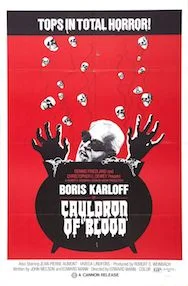Stationary, Blind and Venerable: Cauldron of Blood (1970)
Dear readers, as my years accumulate like so much dust on the lectern, I find myself hoping that in the twilight of my existence, I am able to maintain some posture of dignity. Not some hobbled, gibbering simpleton with splashes of this morning’s porridge adorning my sweater vest but a seasoned gentleman. Slower, yes, but venerable and as upright as can be managed. I hope to model myself on the dignitaries of my most cherished genres and as such I find myself visiting their late-career work with greater urgency as the years pass, which is how I found myself warming myself one wintry eve on the psychedelic glow of Cauldron of Blood.
Portrait of an artist as an elderly invalid
Borrowing its premise from A Bucket of Blood (1959) and upping the volume of its titular vessel, Cauldron of Blood tells the tale of Franz Badulescu (Boris Karloff) a blind sculptor who uses the remains of living beings for his apertures. Actual bones form the structure for Badulescu's pieces, a method akin to the popular Body Worlds exhibits. But just like the work of Dr. von Hagens, one cannot help but wonder how the raw materials are sourced. As luck would have it, an opportunistic rascal of a journalist (Claude Marchand) finds himself pondering that very question just as a number of locals mysteriously disappear.
The source of Badulescu’s materials may lie with his enigmatic wife Tania (Viveca Lindfors), a social string puller and brand builder who seems to be the secret to his success. Early on it is made clear that this is no “love match” but rather a situation where two are bound together like mutual hostages. Tania does seem to be an advantaged hostage, what with having her sight and all. But there is still enough sinister back and forth between the two of them to keep audiences guessing at the secrets that lurk beneath their veneer of marital and material success.
A colorful Karloffian whirl
Though he hides behind the Anglo Saxon moniker “Edward Mann,” director Santos Alcocer’s in unable to conceal his Spanish heritage and his film is flush with the feeling of Mediterranean horror. The colors are lush, the interiors are ornate and the relationships are unhealthy. All that’s missing from the conclusion is Karloff’s villa being consumed by roaring flames. Mr. Alcocer has also adorned this film with a score and a color palette that reflects the era in which it was made as plainly as a pair of bell-shaped trousers. In keeping with the influence of the 1960’s, the film includes a few hallucinatory sequences. Though some cynical viewers might suspect these are a craven marketing scheme engineered to lure in in the youths, they are vibrant little numbers and their presence liven up the mood.
Excepting perhaps Vincent Price in Edward Scissorhands (1990) and Christopher Lee’s turn as Saruman, the later efforts of horror’s finest figures are rarely the subject of extensive discussion and as such often go unnoticed. Nevertheless, I am absolutely gobsmacked by the lack of merry trumpeting over this late-career effort from one of horror’s most beloved statesmen. Time did not diminish Karloff’s command of the screen and Cauldron of Blood is not one of those dubious projects that old age sometimes visits upon even the savviest of thespians. Even reduced to a chair and robbed of his eyes, the man’s presence is undeniable and the melliferous tones of Boris Karoff’s voice lift the spirits most thoroughly.
I can only hope that in my own experiences with seniority are as stately and productive.
Cauldron of Blood runs 95 minutes and is rated PG.


